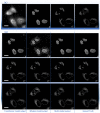Multiple Parallel Fusion Network for Predicting Protein Subcellular Localization from Stimulated Raman Scattering (SRS) Microscopy Images in Living Cells
- PMID: 36142736
- PMCID: PMC9504098
- DOI: 10.3390/ijms231810827
Multiple Parallel Fusion Network for Predicting Protein Subcellular Localization from Stimulated Raman Scattering (SRS) Microscopy Images in Living Cells
Abstract
Stimulated Raman Scattering Microscopy (SRS) is a powerful tool for label-free detailed recognition and investigation of the cellular and subcellular structures of living cells. Determining subcellular protein localization from the cell level of SRS images is one of the basic goals of cell biology, which can not only provide useful clues for their functions and biological processes but also help to determine the priority and select the appropriate target for drug development. However, the bottleneck in predicting subcellular protein locations of SRS cell imaging lies in modeling complicated relationships concealed beneath the original cell imaging data owing to the spectral overlap information from different protein molecules. In this work, a multiple parallel fusion network, MPFnetwork, is proposed to study the subcellular locations from SRS images. This model used a multiple parallel fusion model to construct feature representations and combined multiple nonlinear decomposing algorithms as the automated subcellular detection method. Our experimental results showed that the MPFnetwork could achieve over 0.93 dice correlation between estimated and true fractions on SRS lung cancer cell datasets. In addition, we applied the MPFnetwork method to cell images for label-free prediction of several different subcellular components simultaneously, rather than using several fluorescent labels. These results open up a new method for the time-resolved study of subcellular components in different cells, especially cancer cells.
Keywords: deep learning; label-free live cell imaging; multiple parallel fusion network; nonlinear optical microscopy; protein subcellular localization.
Conflict of interest statement
The authors declare no conflict of interest.
Figures

















Similar articles
-
Label-Free Cytometric Evaluation of Mitosis via Stimulated Raman Scattering Microscopy and Spectral Phasor Analysis.Anal Chem. 2023 May 9;95(18):7244-7253. doi: 10.1021/acs.analchem.3c00212. Epub 2023 Apr 25. Anal Chem. 2023. PMID: 37097612 Free PMC article.
-
Pixel-level multimodal fusion deep networks for predicting subcellular organelle localization from label-free live-cell imaging.Front Genet. 2022 Oct 26;13:1002327. doi: 10.3389/fgene.2022.1002327. eCollection 2022. Front Genet. 2022. PMID: 36386823 Free PMC article.
-
Fast vibrational imaging of single cells and tissues by stimulated Raman scattering microscopy.Acc Chem Res. 2014 Aug 19;47(8):2282-90. doi: 10.1021/ar400331q. Epub 2014 May 28. Acc Chem Res. 2014. PMID: 24871269 Free PMC article.
-
Imaging chemistry inside living cells by stimulated Raman scattering microscopy.Methods. 2017 Sep 1;128:119-128. doi: 10.1016/j.ymeth.2017.07.020. Epub 2017 Jul 23. Methods. 2017. PMID: 28746829 Review.
-
Stimulated Raman scattering microscopy in chemistry and life science - Development, innovation, perspectives.Biotechnol Adv. 2022 Nov;60:108003. doi: 10.1016/j.biotechadv.2022.108003. Epub 2022 Jun 9. Biotechnol Adv. 2022. PMID: 35690271 Review.
Cited by
-
Fast Real-Time Brain Tumor Detection Based on Stimulated Raman Histology and Self-Supervised Deep Learning Model.J Imaging Inform Med. 2024 Jun;37(3):1160-1176. doi: 10.1007/s10278-024-01001-4. Epub 2024 Feb 7. J Imaging Inform Med. 2024. PMID: 38326533 Free PMC article.
-
Unveiling precision: a data-driven approach to enhance photoacoustic imaging with sparse data.Biomed Opt Express. 2023 Dec 4;15(1):28-43. doi: 10.1364/BOE.506334. eCollection 2024 Jan 1. Biomed Opt Express. 2023. PMID: 38223183 Free PMC article.
-
Simple quantitation and spatial characterization of label free cellular images.Heliyon. 2024 Nov 23;10(23):e40684. doi: 10.1016/j.heliyon.2024.e40684. eCollection 2024 Dec 15. Heliyon. 2024. PMID: 39759864 Free PMC article.
-
A Review for Artificial Intelligence Based Protein Subcellular Localization.Biomolecules. 2024 Mar 27;14(4):409. doi: 10.3390/biom14040409. Biomolecules. 2024. PMID: 38672426 Free PMC article. Review.
References
MeSH terms
Substances
LinkOut - more resources
Full Text Sources

